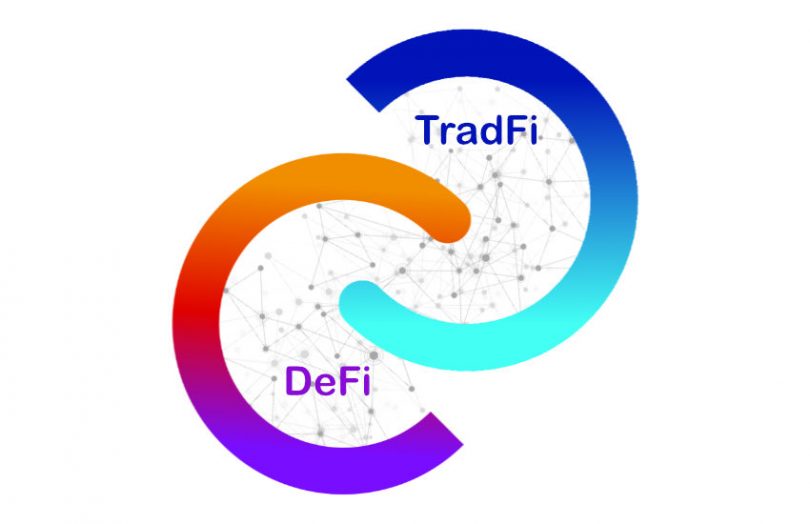This is a guest opinion post from Jake Hartley, Business Development Director at Fnality
Recent advances in technology have enabled decentralised and distributed systems to be considered as meaningful alternatives to traditional solutions and institutions. ‘Decentralised finance’ (DeFi) is characterised by its use of novel technologies – most notably distributed ledger technology (DLT), or blockchain – to offer distributed and disintermediated solutions to the problems that incumbent ‘traditional finance’ (TradFi) actors have typically addressed through centralised and intermediated operations.
A wave of innovative products and approaches has captured the imagination of the industry and has even at times cut through to the general public, with reactions ranging from scepticism to zealotry. Institutional interest in cryptocurrencies is a particularly prominent example of DeFi ideas spurring TradFi actors into committing significant resource towards the understanding, productisation and commercialisation of a distributed, peer-to-peer product underpinned by DLT. But this is only a small part of a much bigger picture.
Many innovative FinTechs are now leveraging the ideas and ideals behind DeFi with a view to challenging TradFi actors on their own turf, potentially threatening the business models and revenue streams of incumbents. Perhaps because of the public fervour surrounding novel assets like cryptocurrencies, the relationship between TradFi and DeFi has often been characterised as adversarial, but this obscures the reality of the situation: a strong desire for integration on both sides, a common goal of making financial markets faster, cheaper and safer, and a determination to utilise new technologies to more effectively solve old problems. Fully realising these aims, however, is not without its challenges.
The challenges of DeFi and TradFi integration
Despite shared ambitions, a primary barrier to the integration of DeFi and TradFi is the marked disparity between the two sectors regarding agility, risk tolerance, and the willingness to embrace disruption. Clayton Christensen’s ‘Innovator’s Dilemma’ theory explains how incumbents can become vulnerable to disruption by doing the ‘right thing’; they often focus more closely on the established end of the market as that is where the highest revenues and their most loyal customers lie.
Innovators may struggle to compete at the established end of the market, but the unfamiliar end of the market is left relatively unprotected. In the world of finance, DeFi innovators have entered financial markets by providing the on-ramp into cryptocurrency markets, but are beginning to expand into other areas, including tokenisation of traditional assets, institutional lending, custody services, the creation of distributed Financial Market Infrastructure (dFMI), and much more – encroaching ever more closely upon the domain of TradFi institutions in the process.
At the moment, incumbents are still relatively untroubled; their core markets remain profitable and unchallenged, and regulatory uncertainty around the legal and prudential treatment of DLT and DeFi solutions still abounds. But the aforementioned activities of insurgents are certainly attracting the attention of regulators, which – alongside increasing customer demand and the progress of others – may open the door to greater legitimacy and formal regulation. This could leave incumbents vulnerable and lagging behind innovators as they expand into their traditional markets.
Furthermore, TradFi – especially in wholesale financial markets – has often been slow to adopt new technology. The risks associated with overhauling or integrating legacy systems with new solutions is an intimidating prospect, erecting another barrier to the convergence of the two spheres.
Is convergence between TradFi and DeFi in the wholesale space inevitable?
Despite the points of divergence outlined above, the increasing preparedness of regulatory bodies, growing demand from businesses and customers, and fundamentally shared aims regarding improving the speed, cost and safety of wholesale financial markets means that TradFi and DeFi convergence is a matter of when, not if. The benefits that each side can provide to the other are too compelling to refuse.
DeFi seeks the legitimacy that can only be gained from full compliance with applicable regulatory bodies and regimes. Full compliance facilitates the safe expansion of DeFi services and the technology that underpins them, promoting more widespread trust and usage and access to a broader institutional consumer base.
On the other hand, TradFi is eager to leverage DeFi technologies such as blockchain in wholesale financial markets to compress settlement times to the same day (T+0). Doing so limits the number of intermediaries required between the initiation of a transaction and final settlement, and harnesses the risk reduction benefits that accrue from the use of DLT. Large wholesale banks in particular can more accurately predict and manage their liquidity requirements by availing themselves of the near-instant peer-to-peer settlement that the technology enables.
Fnality – a consortium of leading global financial institutions – is already leveraging technology associated with DeFi for applications on TradFi systems for these purposes amongst others. Collaborating with both TradFi and DeFi partners in preparation for the platform’s launch in late 2022, Fnality’s payment system can unlock intraday liquidity savings of up to 70% and enable near instant settlement.
What are the requirements for DeFi and TradFi to evolve together?
The successful convergence between DeFi and TradFi will result in the mutually beneficial use of innovative technology to streamline processes, reduce costs, and ensure regulatory compliance while offering new products and accessing new markets. For this to come about, both sides must be assured that this technology is secure, resilient, and compatible, and that the legal framework surrounding it is robust. What is really needed, then, is a foundational, regulated, technologically sound ‘trust layer’ to safely drive this convergence and ensure that both sides fully realise their shared aims.
As a TradFi-backed consortium with both substantial DeFi pedigree and longstanding relationships with key central banks and regulators, Fnality is well placed to sit at the intersection of these converging markets, empowering both sides in the process.
Fnality is a consortium of global banks and FMIs that is building a regulated payment system to support the growing industry adoption of tokenised assets and marketplaces.






